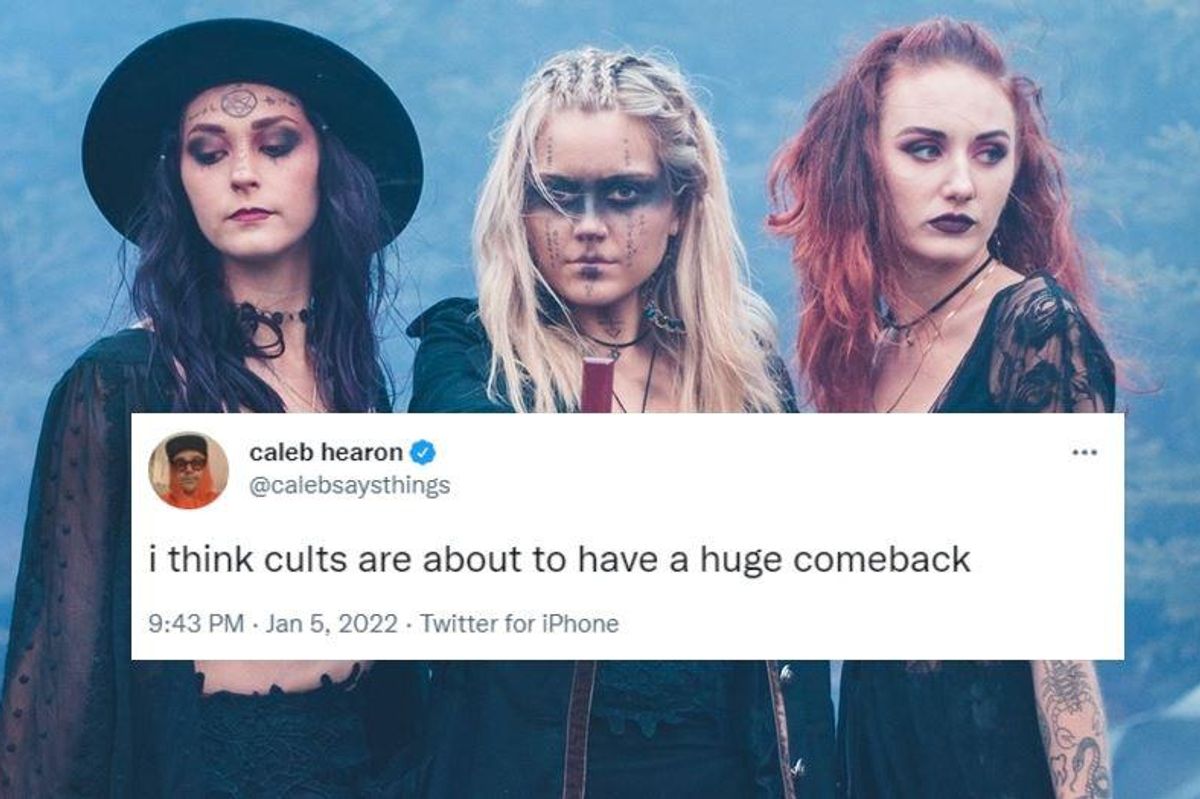Someone predicted that cults will make a 'huge comeback' in 2022, sparking a funny debate

Are cults making a comeback?
Things have definitely taken a turn for the weird in America over the past few years. So much so that I’ve had many a morning where I wake up with the John Lennon song, “Nobody Told Me” stuck in my head.
“Strange days, indeed. Most peculiar, mamma,” Lennon sang on his posthumous hit.
There’s been political unrest, ecological disasters, that weird monolith that popped up in the Utah desert and super credible-looking UFO videos.
Oh yeah, there’s also that pandemic thing that’s still going on.
The sheer absurdity of it all prompted comedian Caleb Hearon to tweet "i think cults are about to have a huge comeback" on Wednesday and a lot of people agreed with him.
i think cults are about to have a huge comeback— caleb hearon (@caleb hearon) 1641447813
It's been said that people often join cults to soothe their fears and anxieties. If that's the case, then Hearon may be right. A recent study found that there was a 26% increase in anxiety worldwide in 2021 due to the pandemic.
To make things even more interesting, there are many who feel anxiety about the pandemic ending because they don’t want to go back to normal.
Hearon's tweet kicked off a great discussion on Twitter on whether or not we’re already in the midst of a cult renaissance.
We've already got the clothes down.
Target has the outfits ready pic.twitter.com/rzrRm3IXDp
— Victoria West 🌈🌻🐝🐾🐶🐱 (@VictoriaEWest) January 6, 2022
the seeds are there https://t.co/5NVmFRu7sR
— ᴛ - ᴍ ᴀ ᴄ ᴛ ɪ ᴏ ɴ (@teemaction) January 6, 2022
Yeah, but if the fashion is this good, sign me up. I am not doing that prairie dress garbage even if it is in style. I want that nutso, futuristic Zardoz dancing around a glowing orb and chanting stuff.
— Heidi (@bleedingblueapp) January 6, 2022
Is the internet already a cult?
We need to bring back old school cults. I’m tryna join a sex commune not a Facebook group.
— Kori W. (@slowbonemahomes) January 6, 2022
Is it happening already?
I definitely think communes will, and yeah, many will turn into cults. I see anti-cell phone communes becoming a big thing.
— Frank Herbie The Love Bug (@EverettWa) January 6, 2022
I mean, have you ever worked at a tech company?
— Amy Isikoff Newell (@amynewell) January 6, 2022
For real I went through the new hire orientation at Tesla years back when I was desperate for work and the it was the most cultish shit I’ve ever seen in my life. I quit before I ever started working in the factory
— ✊🏿James Highsman✊🏿 (@PoorHomieMar) January 6, 2022
The cult of NFT pic.twitter.com/geh9LoCAIX
— King Sized Comforter (@Supertainment) January 6, 2022
Some folks are down already.
should we get in early? what’s the play?
— MITCH (@mitchyytweets) January 6, 2022
It would be great if there was some sort of directory so we could all pick the one that's right for us.
— MakewiEatsSpam (@MakewiEatsSpam) January 6, 2022
Hope so, looking for a good way to offload all these velor tracksuits I've been holding onto...
— a.k.a your mom's pool boy (@thewhitedread) January 6, 2022
If you in Minneapolis and in a cult, I’m available. hml
— Mo (@MoDahga) January 6, 2022
They sound relaxing and homey at this point. Quaint, even.
— Vivien Jastrzebski (@VivienJastrzeb) January 6, 2022
Ready to join
— Zophister (@zophister) January 6, 2022
Cult leaders hit me up I’m lonely desperate and wealthy
— Andy Compton (@andycompton_) January 6, 2022
What cults are we talking about?
You thinking any legacy cults mounting a comeback, or are we talking all new players?
— Christopher Heiner (@Tenaciousheiner) January 6, 2022
Like waco cults or meet in the forst at midnight during a fullmoon for ritual cult?
— Kai Ashworth (@KaiAshworth) January 6, 2022
Let's do this.
What society needs more than anything right now is “family”. You can join mine if you’d like
— DrGodking (@DrGodking) January 6, 2022
After reading the responses it looks like Hearon wasn’t far from the truth. A lot of people raised their hands and said “I’m in” after thinking about the potential benefits that come with being in a cult.
While others claimed there are plenty of cults happening right now, it’s just that people don’t know they’re in them.
Steven Hassan, author of “Combating Cult Mind Control: The Guide to Protection, Rescue and Recovery from Destructive Cults” and a former member of the Moonies, no less, says that there are essentially four types of cults: behavior control, information control, thought control and emotional control.
He also says that just about anyone is susceptible to being the victim of a cult.
"If you think it could never happen to you, then you're the most vulnerable. Because nobody's impervious," he says.
If Hearon is right, there may be some super culty stuff happening all around us in the coming months. If you’re not down for the cult lifestyle, then it’s best to keep your eyes wide open for suspicious groups gathering in unlikely places.
- A former QAnon believer answers all your questions about how the ... ›
- The QAnon cult: What it is, how it works, and how to help deprogram ... ›
- Sex cult leader sentenced to 120 years for child exploitation, sex ... ›

